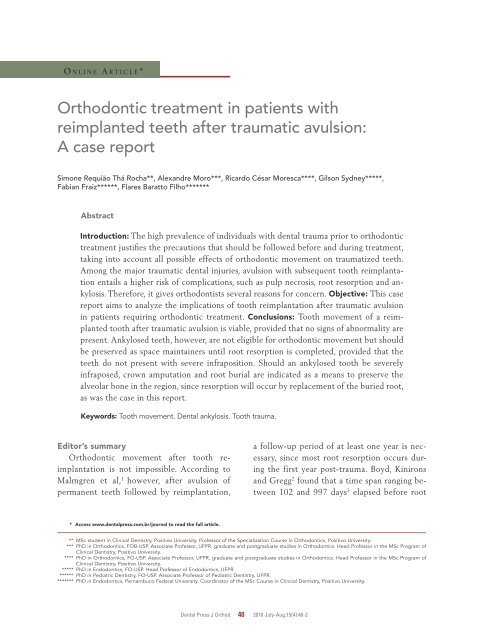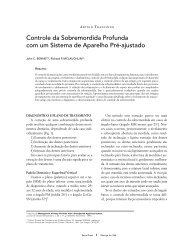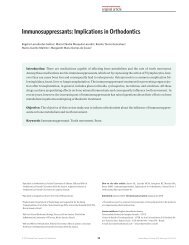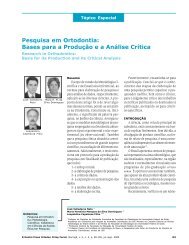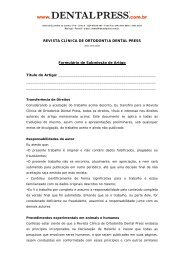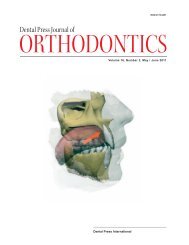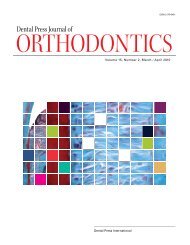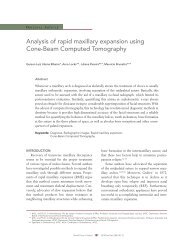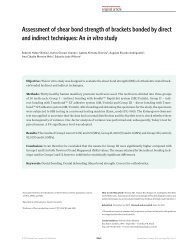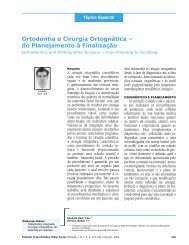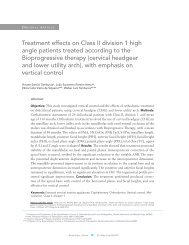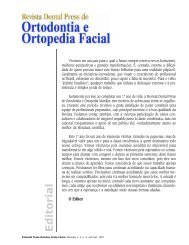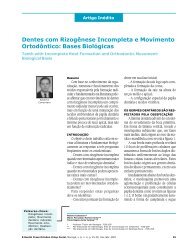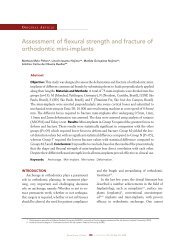Orthodontic treatment in patients with reimplanted ... - Dental Press
Orthodontic treatment in patients with reimplanted ... - Dental Press
Orthodontic treatment in patients with reimplanted ... - Dental Press
Create successful ePaper yourself
Turn your PDF publications into a flip-book with our unique Google optimized e-Paper software.
O n l i n e A r t i c l e *<strong>Orthodontic</strong> <strong>treatment</strong> <strong>in</strong> <strong>patients</strong> <strong>with</strong><strong>reimplanted</strong> teeth after traumatic avulsion:A case reportSimone Requião Thá Rocha**, Alexandre Moro***, Ricardo César Moresca****, Gilson Sydney*****,Fabian Fraiz******, Flares Baratto Filho*******AbstractIntroduction: The high prevalence of <strong>in</strong>dividuals <strong>with</strong> dental trauma prior to orthodontic<strong>treatment</strong> justifies the precautions that should be followed before and dur<strong>in</strong>g <strong>treatment</strong>,tak<strong>in</strong>g <strong>in</strong>to account all possible effects of orthodontic movement on traumatized teeth.Among the major traumatic dental <strong>in</strong>juries, avulsion <strong>with</strong> subsequent tooth reimplantationentails a higher risk of complications, such as pulp necrosis, root resorption and ankylosis.Therefore, it gives orthodontists several reasons for concern. Objective: This casereport aims to analyze the implications of tooth reimplantation after traumatic avulsion<strong>in</strong> <strong>patients</strong> requir<strong>in</strong>g orthodontic <strong>treatment</strong>. Conclusions: Tooth movement of a <strong>reimplanted</strong>tooth after traumatic avulsion is viable, provided that no signs of abnormality arepresent. Ankylosed teeth, however, are not eligible for orthodontic movement but shouldbe preserved as space ma<strong>in</strong>ta<strong>in</strong>ers until root resorption is completed, provided that theteeth do not present <strong>with</strong> severe <strong>in</strong>fraposition. Should an ankylosed tooth be severely<strong>in</strong>fraposed, crown amputation and root burial are <strong>in</strong>dicated as a means to preserve thealveolar bone <strong>in</strong> the region, s<strong>in</strong>ce resorption will occur by replacement of the buried root,as was the case <strong>in</strong> this report.Keywords: Tooth movement. <strong>Dental</strong> ankylosis. Tooth trauma.Editor’s summary<strong>Orthodontic</strong> movement after tooth reimplantationis not impossible. Accord<strong>in</strong>g toMalmgren et al, 1 however, after avulsion ofpermanent teeth followed by reimplantation,a follow-up period of at least one year is necessary,s<strong>in</strong>ce most root resorption occurs dur<strong>in</strong>gthe first year post-trauma. Boyd, K<strong>in</strong>ironsand Gregg 2 found that a time span rang<strong>in</strong>g between102 and 997 days 3 elapsed before root* Access www.dentalpress.com.br/journal to read the full article.** MSc student <strong>in</strong> Cl<strong>in</strong>ical Dentistry, Positivo University. Professor of the Specialization Course <strong>in</strong> <strong>Orthodontic</strong>s, Positivo University.*** PhD <strong>in</strong> <strong>Orthodontic</strong>s, FOB-USP. Associate Professor, UFPR, graduate and postgraduate studies <strong>in</strong> <strong>Orthodontic</strong>s. Head Professor <strong>in</strong> the MSc Program ofCl<strong>in</strong>ical Dentistry, Positivo University.**** PhD <strong>in</strong> <strong>Orthodontic</strong>s, FO-USP. Associate Professor, UFPR, graduate and postgraduate studies <strong>in</strong> <strong>Orthodontic</strong>s. Head Professor <strong>in</strong> the MSc Program ofCl<strong>in</strong>ical Dentistry, Positivo University.***** PhD <strong>in</strong> Endodontics, FO-USP. Head Professor of Endodontics, UFPR.****** PhD <strong>in</strong> Pediatric Dentistry, FO-USP. Associate Professor of Pediatric Dentistry, UFPR.******* PhD <strong>in</strong> Endodontics, Pernambuco Federal University. Coord<strong>in</strong>ator of the MSc Course <strong>in</strong> Cl<strong>in</strong>ical Dentistry, Positivo University.<strong>Dental</strong> <strong>Press</strong> J Orthod 40 2010 July-Aug;15(4):40-2
Rocha SRT, Moro A, Moresca RC, Sydney G, Fraiz F, Baratto F Filhoresorption was detected, suggest<strong>in</strong>g the needfor a longer follow-up period before start<strong>in</strong>gorthodontic <strong>treatment</strong>.When the periodontal ligament experiencesextensive damage a small amount of surviv<strong>in</strong>gcells near the root surface triggers a repairprocess through rapid osteogenesis, lead<strong>in</strong>g toankylosis of the tooth 4 and its subsequent lossand replacement. Alveolodental ankylosis <strong>in</strong>volvesfusion of the alveolar bone <strong>with</strong> the rootsubstance and consequent disappearance of theperiodontal space, which loses its structure andfunction. The close contact between dental tissuesand alveolar bone structure furthers thebone remodel<strong>in</strong>g process. This results <strong>in</strong> resorptionof bone tissue and part of the tooth tissue,which will be partially or totally replacedby new bone formation. Resorption by replacement<strong>in</strong>creases if the avulsed tooth is allowedto rema<strong>in</strong> outside the oral cavity for extendedperiods of time. It ranges from only 9.5% resorption<strong>in</strong> short periods (fewer than fifteenm<strong>in</strong>utes) to 100% resorption if periods exceedsixty m<strong>in</strong>utes, <strong>in</strong> a dry medium. 5Extraction is recommended <strong>in</strong> cases of <strong>in</strong>cl<strong>in</strong>edadjacent teeth or extensive <strong>in</strong>fraposition.1 In other cases, teeth should be exam<strong>in</strong>edat <strong>in</strong>tervals of six months until root resorptionceases and the tooth crown either comes looseor can be removed <strong>with</strong> forceps, after most ofthe root has been replaced by bone. 6 Cl<strong>in</strong>icalexperience has shown that extraction of ankylosedteeth <strong>in</strong>volves substantial bone loss bothhorizontally and vertically, which affects, <strong>in</strong> particular,the th<strong>in</strong> buccal bone wall <strong>in</strong> the maxilla.6 To prevent this loss, Malmgren 1,6 describeda technique that <strong>in</strong>volves removal of the toothcrown <strong>with</strong> subsequent closure of the alveolus<strong>with</strong> the root <strong>in</strong>side it. When resorption by rootreplacement takes place it preserves or even enhancesalveolar bone height <strong>in</strong> the vertical direction.It also preserves the alveolar bone <strong>in</strong>the buccol<strong>in</strong>gual direction, which improves theconditions for orthodontic <strong>treatment</strong>—if necessary—and/orsubsequent placement of a prosthesisand/or implant.Ankylosed teeth should therefore be preservedas space ma<strong>in</strong>ta<strong>in</strong>ers until root resorptionis completed, provided that the teeth donot present <strong>with</strong> severe <strong>in</strong>fraposition. Should anankylosed tooth be severely <strong>in</strong>fraposed, crownamputation and root burial are <strong>in</strong>dicated as ameans to preserve the alveolar bone <strong>in</strong> the region,s<strong>in</strong>ce resorption will occur by replacementof the buried root, as was the case <strong>in</strong> this report.Questions to the authors1) What precautions should professionalsfollow when plann<strong>in</strong>g orthodontic <strong>treatment</strong>for <strong>patients</strong> <strong>with</strong> a history of trauma?Orthodontists should first perform a carefulanamnesis look<strong>in</strong>g for <strong>in</strong>formation about the historyof trauma. Injuries to the teeth <strong>in</strong>volve multipleconsequences rang<strong>in</strong>g from a small crack <strong>in</strong>the enamel to tooth loss. Some lighter <strong>in</strong>juriesrarely pose a risk to the health or survival of atraumatized tooth, while others are more severe,such as <strong>in</strong>trusions and avulsions followed by reimplantation,and pose a greater risk of complications,<strong>in</strong>clud<strong>in</strong>g pulp necrosis, root resorption tothe extent of marg<strong>in</strong>al bone loss and subsequenttooth loss. The prognosis for several types oftrauma seems to depend on the type and severityof the <strong>in</strong>jury (measured by the extent of damageto the periodontal ligament). A detailed cl<strong>in</strong>icalradiographic(periapical) assessment can providea thorough diagnosis of pulp changes, crownfractures, root fractures, possible root resorptionprior to orthodontic <strong>treatment</strong>, and ankylosis.<strong>Dental</strong> <strong>Press</strong> J Orthod 41 2010 July-Aug;15(4):40-2
<strong>Orthodontic</strong> <strong>treatment</strong> <strong>in</strong> <strong>patients</strong> <strong>with</strong> <strong>reimplanted</strong> teeth after traumatic avulsion: A case reportIn some cases, a scan of the traumatized toothmay reveal images that go unnoticed <strong>in</strong> radiographs.Should the <strong>in</strong>jured tooth show no cl<strong>in</strong>icalor radiographic changes, a post-trauma periodshould be observed—three months <strong>in</strong> cases ofm<strong>in</strong>or <strong>in</strong>juries such as coronal or coronoradicularfractures <strong>with</strong>out pulp <strong>in</strong>volvement, concussionand subluxation, and 1 to 2 years <strong>in</strong> cases of rootfractures, <strong>in</strong>trusion, reimplantation after avulsionand lateral luxation <strong>with</strong> moderate or severedisplacement—, and then orthodontic <strong>treatment</strong>can be performed normally. Orthodontists willnot be able to move ankylosed teeth because theyare not amenable to orthodontic movement. Radiographicfollow-up throughout the orthodontic<strong>treatment</strong> is also essential.2) Is tooth reimplantation a contra<strong>in</strong>dicationto orthodontic <strong>treatment</strong>?Tooth avulsion <strong>with</strong> subsequent reimplantationis the traumatic <strong>in</strong>jury that <strong>in</strong>volves thegreatest risk of complications due to a high likelihoodof bacterial <strong>in</strong>fection through both thepulp and the periodontium. However, the orthodonticmovement of <strong>reimplanted</strong> teeth is possible,provided that normal conditions are restoredand ma<strong>in</strong>ta<strong>in</strong>ed for period of at least one year<strong>with</strong> cl<strong>in</strong>ical-radiographic follow-up. Accord<strong>in</strong>gto Malmgren et al, 1 most root resorption afterreimplantation occurs dur<strong>in</strong>g the first year posttrauma.Boyd, K<strong>in</strong>irons and Gregg 2 found that atime span rang<strong>in</strong>g between 102 and 997 days 3elapsed before root resorption was detected, suggest<strong>in</strong>gthe need for a longer follow-up periodbefore start<strong>in</strong>g orthodontic <strong>treatment</strong>.3) Is there general agreement <strong>in</strong> the literatureregard<strong>in</strong>g orthodontic <strong>treatment</strong> <strong>in</strong> <strong>patients</strong><strong>with</strong> traumatized teeth or are therestill different approaches to this issue?The literature is <strong>in</strong>deed very consistent <strong>in</strong> thisregard. <strong>Dental</strong> trauma does not contra<strong>in</strong>dicateorthodontic <strong>treatment</strong>, provided there are nopulp or periodontal changes and/or root resorption.However, some studies <strong>in</strong>dicate that traumatizedteeth are more predisposed to resorption.But these f<strong>in</strong>d<strong>in</strong>gs are not conclusive because thef<strong>in</strong>al outcome of traumatized tooth <strong>treatment</strong>can take more than five years to surface. This isone of the factors hamper<strong>in</strong>g the analysis of theeffects of orthodontic movement on traumatizedteeth. These studies <strong>in</strong>volve a small number of<strong>patients</strong>, who present <strong>with</strong> different types of<strong>in</strong>juries and are treated by different researchersus<strong>in</strong>g a variety of orthodontic appliances. Thesefactors comb<strong>in</strong>e to render <strong>in</strong>conclusive any f<strong>in</strong>d<strong>in</strong>gsregard<strong>in</strong>g the effects of orthodontic <strong>treatment</strong>on traumatized teeth.ReferEncEs1. Malmgren O, Malmgren B, Goldson l. Abordagem ortodônticada dentição traumatizada. In: Andreasen JO, Andreasen FM.Texto e atlas colorido de traumatismo dental. 3ª ed. PortoAlegre: Artmed; 2001.2. Boyd DH, K<strong>in</strong>irons MJ, Gregg TA. A prospective study of factorsaffect<strong>in</strong>g survival of replanted permanent <strong>in</strong>cisors <strong>in</strong> children. IntJ Paediatr Dent. 2000 Sep;10(3):200-5.3. K<strong>in</strong>irons MJ, Boyd DH, Gregg TA. Inflammatory andreplacement resorption <strong>in</strong> <strong>reimplanted</strong> permanent <strong>in</strong>cisor teeth:a study of the characteristics of 84 teeth. Endod Dent Traumatol.1999 Dec;15(6):269-72.4. Andreasen JO. Relationship between cell damage <strong>in</strong> theperiodontal ligament after replantation and subsequentdevelopment of root resorption. Acta Odontol Scand.1980;39:15-25.5. Chappuis V, von Arx T. Replantation of 45 avulsed permanentteeth: a 1-year follow-up study. Dent Traumatol. 2005Oct;21(5):289-96.6. Malmgren B, Cvek M, Lundberg M, Frykholm A. Surgical<strong>treatment</strong> of ankylosed and <strong>in</strong>frapositioned <strong>reimplanted</strong> <strong>in</strong>cisors<strong>in</strong> adolescents. Scand J Dent Res. 1984 Oct;92(5):391-9.Contact addressSimone Requião Thá RochaAv. Visconde de Guarapuava, 4663, ap. 2301 – BatelCEP: 80.240-010 – Curitiba / PR, BrazilE-mail: simone_tha@hotmail.com<strong>Dental</strong> <strong>Press</strong> J Orthod 42 2010 July-Aug;15(4):40-2


